Fishing Community Improves Lake Monroe Habitats
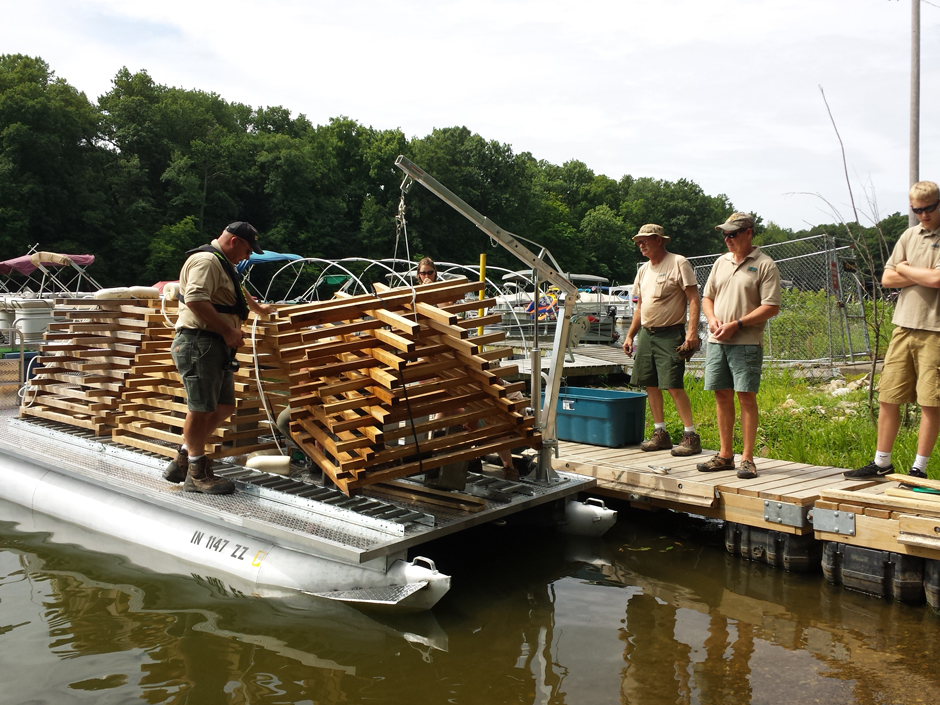 Pontoon boat carrying fish habitat structures (Credit: David Kittaka / IN Department of Natural Resources)
Pontoon boat carrying fish habitat structures (Credit: David Kittaka / IN Department of Natural Resources)Lake Monroe is a popular fishing spot for all types of anglers, but especially bass anglers. Just this spring, an angler broke the state’s smallmouth bass record, held since the 70s, by an entire pound, weighing in at 8 pounds and 3.6 ounces. The lake hasn’t always had such a positive reputation in the bass angler community, once given the nickname “Dead Sea” due to a presumed largemouth bass decline.
In 2015, the Indiana Department of Natural Resources (DNR) conducted a creel survey showing that crappie and bass were the most sought-after species on Lake Monroe, with crappie being the number one harvested species and bass being a popular catch and release species. The survey addressed the angling and fish community as a whole, and when compared to previous surveys, the community targeted the same fish species now as they have in the past.
These steady angler efforts indicate that the bass fishery is still thriving, as David Kittaka, a fisheries biologist for the Indiana DNR, believes that anglers would shift efforts to another water body or species if bass populations had declined.
Kittaka explained that they asked survey questions such as, “How long were you fishing today? And how many fish did you catch?” So they could calculate how long it takes anglers to catch a fish, proving that the fishery wasn’t declining in Lake Monroe but that angler participation was an entirely separate problem.

Staff standing with some of the artificial fish habitat structures named Hoosier Cubes (Credit: David Kittaka / IN Department of Natural Resources
How has Social Media Transformed Fishing?
Kittaka’s running theory is that outdoor activities, in general, are having a hard time competing with technology like cell phones or video games. Summer travel and recreation away from the lake can also limit the number of anglers making it out onto the water each season.
He explains, “There’s so many different things to distract them away from fishing now.” In contrast, he recalls 2020 saying, “A good example of that was COVID. In 2020, our license sales exploded.”
With no more social events or going out, sitting in a state park or fishing was the best way to get out of the house and away from the constant screens.
Kittaka states that, while the license sales are still up from pre-COVID, he’ll be interested to see how that changes as people return to normal in the coming years. He continues, “But hopefully, they’ll see that fishing and being outside and boating is just one of those fairly inexpensive options to have a good time.”
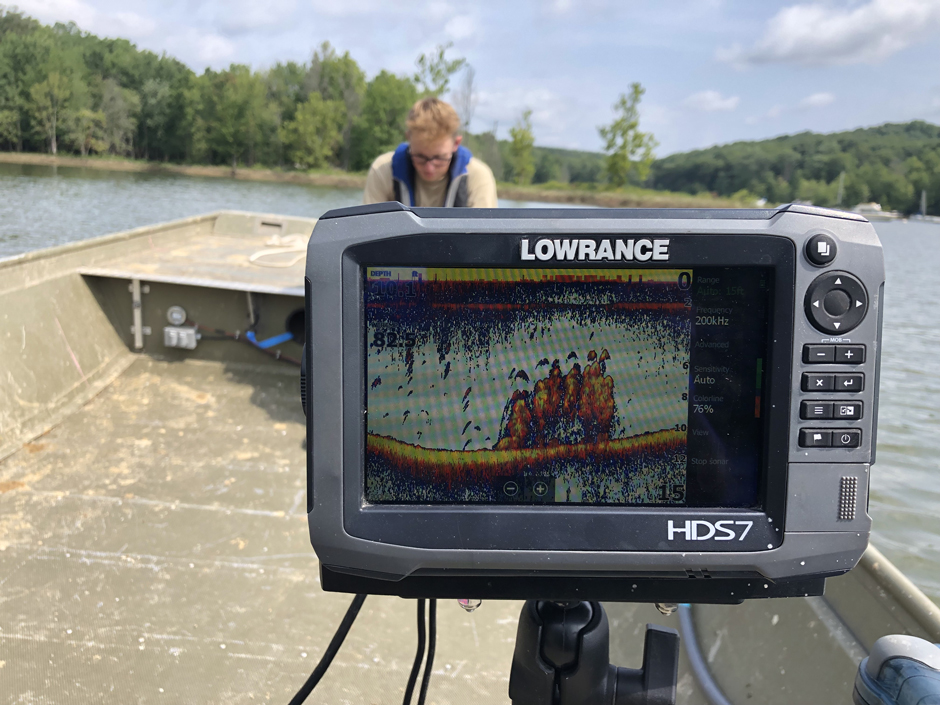
Sonar image of the Hoosier Cube structure underwater. (Credit: David Kittaka /IN Department of Natural Resources)
Although distracting, social media also helps the Indiana DNR monitor Lake Monroe when they aren’t conducting a formal survey. While having the data is convenient, creel surveys aren’t something the state’s DNR can do yearly.
Kittaka explains, “It’s a very expensive project, to have a creel survey, because we hired two people to sit on boat ramps and interview anglers all summer long.”
In place of creel surveys, the state’s DNR relies on data from fishing tournaments to gauge current populations. In Indiana, fishing tournaments include a bag limit, meaning that anglers can only catch a set number of fish that are then brought in for scoring at the end of the tournament. The Indiana DNR looks at how many boats were able to reach the bag limit and reviews the weigh-in data of the caught fish to compare it to historic catch rates and participation.
Social media posts can also provide valuable information to the department, as they can get unofficial data from posts.
Kittaka explains, “Whether they want to brag about the big fish they catch or they really want to help their fellow angler out–either way, it’s become a sort of a self-promoting thing.”
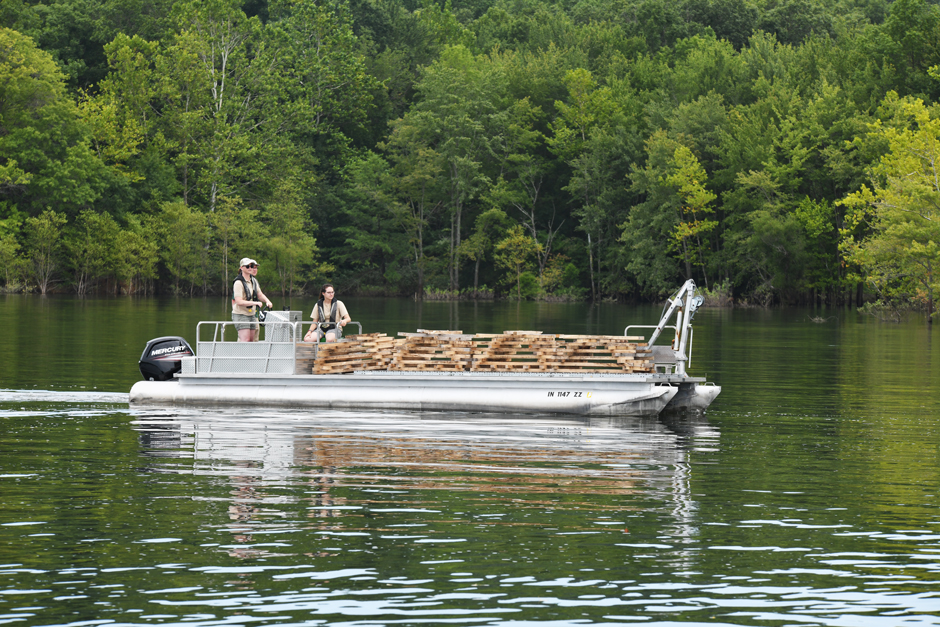
Fish habitat pontoon boat towing habitat structures (Credit: David Kittaka / IN Department of Natural Resources)
Improving Lake Monroe’s Habitat
The condition of the lake’s habitat typically reflects the state of its angling efforts. The U.S. Fish and Wildlife Service created the Reservoir Fish Habitat Partnership in 2009. In 2014, Indiana became more involved with this group, and the DNR installed habitats on smaller reservoirs starting in 2016. By 2019, the Indiana DNR was ready to take on the largest inland waterbody in the state, Lake Monroe.
With the help of sponsors and volunteers, Indiana DNR fish biologists constructed 211 fish habitat structures. The underwater stream channel area where they were placed enhanced fish habitat in approximately 35 to 40 acres of water.
Each of those structures or clusters of structures is marked with a waypoint on an online fish habitat map that anglers can pull up on their phone and download the waypoints to their fish finder, a device using sonar to find fish underwater and other related underwater information.
Kittaka explains, “So now we have a downloadable file that you could put on your SD card, and plug it right into your machine, and then it’ll pop right up on your fish map.”
Stable weather and water levels allow established submerged aquatic vegetation to thrive during the spring and summer growing seasons. However, prolonged local flooding–or elsewhere in the watershed–can raise the water enough to change light penetration dynamics in Lake Monroe, limiting the reach of photosynthetic active radiation.
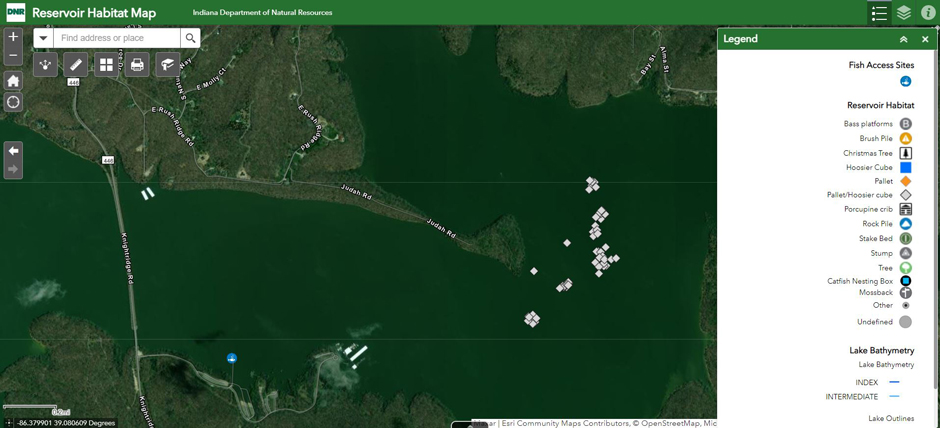
Interactive fish habitat map of the Monroe Lake habitat area (Credit: David Kittaka / IN Department of Natural Resources)
In order to resolve this, the U.S. Army Corp of Engineers (USACE) will hold water to help control water levels downstream in Lake Monroe. Without intervention, the high water levels during the growing season will not allow enough sunlight to penetrate through the water column, limiting the ability of these plants to grow–the impact of which will take years to recover.
The recent 3-4 years of stable water levels have allowed plant communities to thrive, thanks to a combination of both weather patterns and water level control by the USACE, which works to maintain stable water levels throughout the year.
Since 2019, Lake Monroe’s plant community abundance has been on an upward trend. In 2024, there was a surplus of largemouth bass fry produced in Indiana state hatcheries. At this time, Lake Monroe was deemed the best fit for these surplus bass since the nursery habitat–comprised of these submerged aquatic plant species–was abundant this year.
Like most midwestern reservoirs, Lake Monroe’s largemouth bass populations are self-sustaining and do not require supplemental bass stocking to sustain a population. Following strict fish health guidelines and the proper permits, the Indiana DNR will, on special projects, allow promotional bass stocking from private clubs.
Furthering Research
For long-term monitoring of Lake Monroe, the Indiana DNR conducts a statewide status and trends fish survey program for reservoirs. This survey includes documenting the collection of a species as well as the sizes and growth of game fish species. An aquatic plant survey is also part of the survey to document fish habitat and the plant community.
These surveys are on a 5- to 6-year rotation for over 120 reservoirs larger than 15 acres in the state. Lake Monroe was surveyed around 5 years ago, and Kittaka indicates they’ll survey it again soon. While the Indiana DNR is trying to make survey reports more accessible online, no data or reports will be released until the department has approved them.
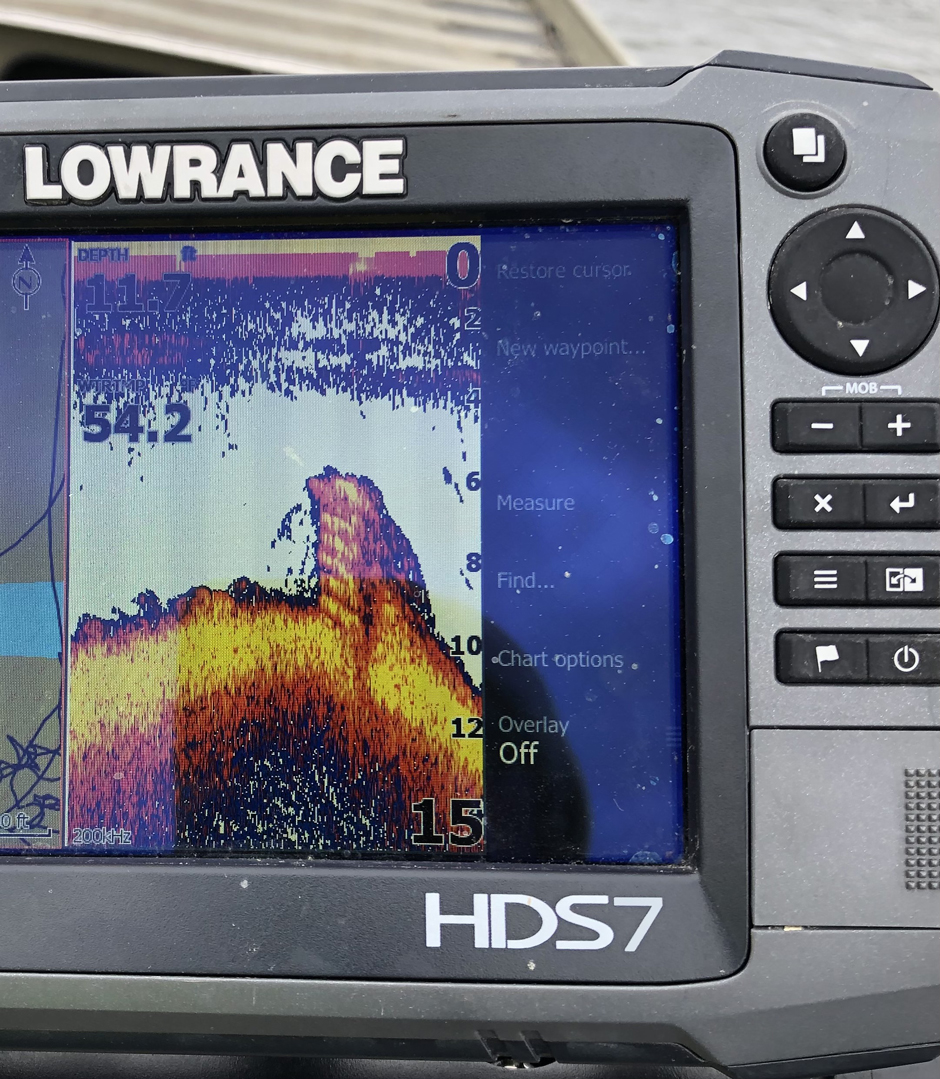
A pallet fish habitat structure pictured on down imaging sonar (Credit: David Kittaka / IN Department of Natural Resources
Conclusion
The online Record Fish Program has allowed fish managers to document the interests of the angling community in a way that would not normally be documented in a standard onsite stream or lake survey.
The online program makes documenting record catches much easier for the average angler, giving the DNR data even when they can’t make it to the lake to conduct creel surveys. This has been a great program to get anglers excited about fishing and to acknowledge the success of catching a big or unique fish species.
The project also allows the DNR to connect with anglers more personally. For example, a couple brought in a big crappie to be weighed for the state record and while the woman’s white crappie was only 0.60 pounds away from breaking the state record, it was a great experience for both the anglers and biologists.
Kittaka recalls the event, stating, “Either way, a four-pound crappie is a pretty big crappie. […] I’ve never seen a crappie that big. I was really excited to see that.”
The couple still entered the Fish of the Year program because the contest winners are decided by the longest total length, not weight.
Kittaka shares, “And her quote was, ‘This is the best Mother’s Day gift ever.’”
Social media and fishing programs like these allow better communication between anglers and help the Indiana DNR promote fishing resources statewide. The state’s DNR may not be able to control lake conditions because of weather and various environmental factors, but they can monitor it and adjust their management priorities based on sound science and angler input.
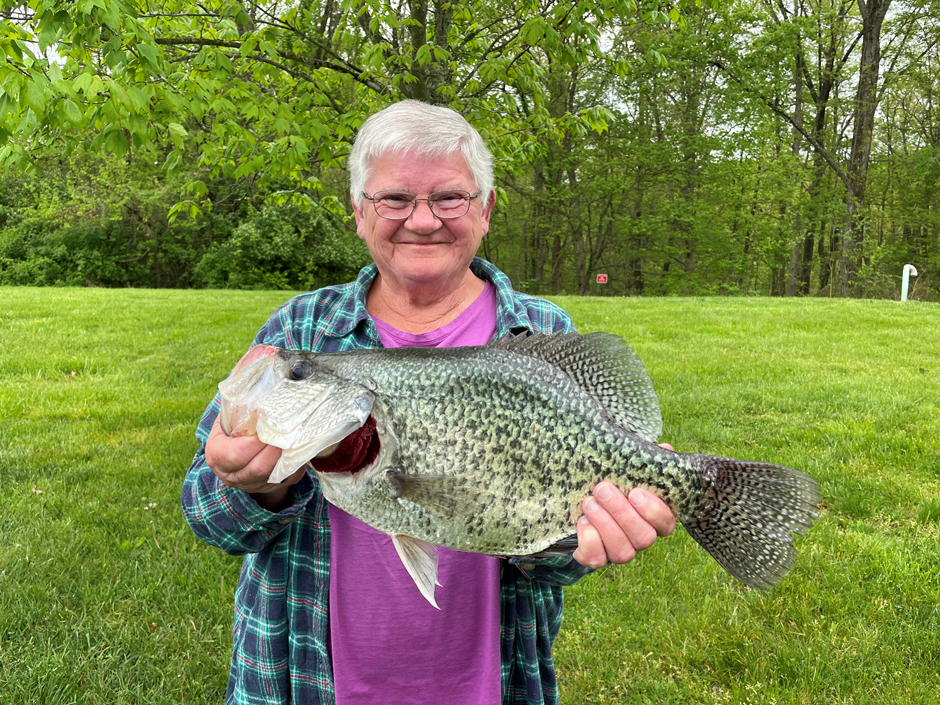
4.08lb white crappie caught in Monroe Lake (Credit: David Kittaka / IN Department of Natural Resources)


0 comments